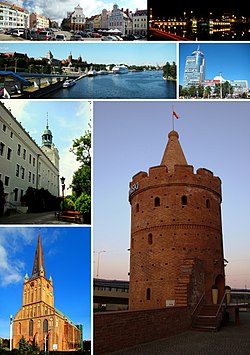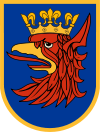Szczecin
| Szczecin | |||
|---|---|---|---|

Top: Market; Old Town Hall, The Oder
Middle: National Sea Museum, PAZIM building Bottom: Ducal Castle, St James' Cathedral, Virgin Tower |
|||
|
|||
| Motto: "Szczecin jest otwarty" ("Szczecin is open") |
|||
| Coordinates: 53°25′57″N 14°32′53″E / 53.43250°N 14.54806°E | |||
| Country | Poland | ||
| Voivodeship | West Pomeranian | ||
| County | city county | ||
| Established | 8th century | ||
| Town rights | 1243 | ||
| Government | |||
| • Mayor | Piotr Krzystek | ||
| Area | |||
| • City | 301 km2 (116 sq mi) | ||
| Population (2015) | |||
| • City | 405,657 | ||
| • Density | 1,300/km2 (3,500/sq mi) | ||
| • Metro | 777,000 | ||
| Time zone | CET (UTC+1) | ||
| • Summer (DST) | CEST (UTC+2) | ||
| Postal code | PL-70-017 to 71–871 |
||
| Area code(s) | +48 91 | ||
| Car plates | ZS | ||
| Website | http://www.szczecin.pl | ||
Szczecin (/ˈʃtʃɛtʃɪn/; Polish pronunciation: [ˈʂt͡ʂɛt͡ɕin]; German and Swedish: Stettin, known also by other alternative names) is the capital city of the West Pomeranian Voivodeship in Poland. Located near the Baltic Sea, it is a major seaport and Poland's seventh-largest city. As of June 2011, the population was 407,811.
Szczecin is located on the Oder, south of the Szczecin Lagoon and the Bay of Pomerania. The city is situated along the southwestern shore of Dąbie Lake, on both sides of the Oder and on several large islands between the western and eastern branches of the river. Szczecin is adjacent to the town of Police and is the urban centre of the Szczecin agglomeration, an extended metropolitan area that includes communities in the German states of Brandenburg and Mecklenburg-Vorpommern.
The city's recorded history began in the 8th century as a Slavic Pomeranian stronghold, built at the site of the Ducal castle. In the 12th century, when Szczecin had become one of Pomerania's main urban centres, it lost its independence to Piast Poland, the Duchy of Saxony, the Holy Roman Empire and Denmark. At the same time, the House of Griffins established themselves as local rulers, the population was Christianized, and German settlers arrived from Western European states. The native Slavic population was subjected to discrimination and Germanization in the following centuries. Between 1237 and 1243, the town was rebuilt, granted extensive autonomy rights and eventually joined the Hanseatic League.
...
Wikipedia



